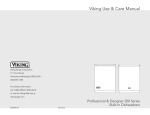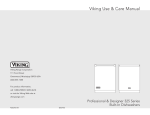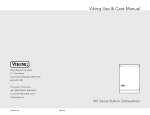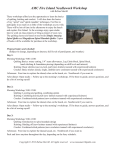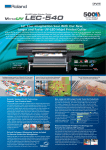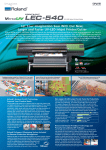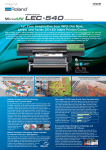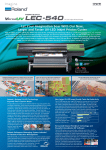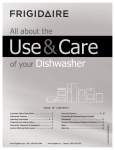Download Frigidaire MDS251RHR Dishwasher
Transcript
Dishwasher Use & Care Manual 18” Built-In & Portable Product Registration Card Please fill in completely, sign and return promptly! Safety Instructions ........................ 2 Features .............................. 3 Operating Instructions ...................... 4-5 Preparing and Loading Dishes ............... 5-7 Dishwasher Dispenser and Detergents .................. 8 Factors Affecting Performance ....................... 9 Care and Cleaning .......................... 9-10 Record All Information For Future Reference Brand: Purchase Date: Connecting Portable Dishwasher ........ 11 Changing Color Panels ...................... 12 Model #: Serial #: (see Features page for location) Questions? 1-800-444-4944 (United States) 1-800-661-9913 (Canada) Solutions to Common Dishwasher Problems .. 13-14 Troubleshooting ............... 14 Consumer Services Warranty & Service .......................... 15-16 Versión en español .............................. 15 Visit Frigidaire Company's Web Site at http://www.frigidaire.com READ AND SAVE THESE INSTRUCTIONS P/N 154354201(9812) Important Safety Instructions • Store dishwasher detergent and rinse agents out of the reach of children. • Do not wash plastic items unless marked “dishwasher safe” or the equivalent. Check with manufacturer for recommendations, if not marked. Items that are not dishwasher safe may melt and create a potential fire hazard. • If the dishwasher drains into a food disposer, make sure disposer is completely empty before running dishwasher. • Disconnect electrical power to dishwasher before servicing. • Repairs should be done by a qualified technician. • Do not tamper with controls. • Do not touch the heating element during or immediately after use. • When loading items to be washed: - Locate sharp items and knives so that they are not likely to damage the door seal or tub. - Load sharp items and knives with the handles up to reduce the risk of cut-type injuries. • Under certain conditions, hydrogen gas may be produced in a hot water system that has not been used for 2 weeks or more. HYDROGEN GAS IS EXPLOSIVE. If hot water system has not been used for such a period, before using dishwasher, turn on all hot water faucets and let water flow from each for several minutes. This will release any accumulated hydrogen gas. HYDROGEN GAS IS FLAMMABLE. Do not smoke or use an open flame during this time. • Do not store or use combustible materials, gasoline or other flammable vapors and liquids in the vicinity of this or any other appliance. This symbol will help alert you to such dangers as personal injury, burns, fire and electrical shock. To reduce the risk of fire, electrical shock, or injury when using your dishwasher, follow basic precautions including the following: • Read all instructions before using your dishwasher. • Use your dishwasher only as instructed in this Use and Care Manual. • This Manual does not cover every possible condition and situation that may occur. Use common sense and caution when installing, operating and maintaining any appliance. • DISHWASHER MUST BE ELECTRICALLY GROUNDED. Read the Installation Instructions for details. • This dishwasher is designed to operate on regular house current (120 V, 60 Hz). Use a circuit equipped with a 15 ampere fuse or circuit breaker. Use a 20 ampere fuse if dishwasher is connected with a food waste disposer. • Do not operate dishwasher unless all enclosure panels are in their proper place. • Dispose of discarded appliance and shipping or packing material properly. • To avoid entrapment and/or suffocation, remove door or door latch mechanism from any dishwasher that is discarded or not in use. • Keep young children and infants away from dishwasher when it is operating. • Do not let children abuse, sit, stand or play on door or racks of a dishwasher. • Use only detergents and rinse agents recommended for use in a dishwasher. SAVE THESE INSTRUCTIONS ©1998 White Consolidated Industries, Inc. All rights reserved. Printed in U.S.A. 2 Dishwasher Features Your dishwasher, illustrated below, cleans by spraying a mixture of hot, clean water, and detergent against the soiled surfaces of your dishes and tableware. Each cycle starts with a pre-drain. Next, the dishwasher fills with water to a level even with the heating element. This water is constantly pumped through the rotating spray arm and center wash tower and sprayed onto the dishes. Soiled water is pumped out and replaced with clean water during a cycle. The number of water fills depends upon the cycle being used. Console page 4 Top Rack page 6 Serial label (located on right side of tub) Tower Assembly pages 6,9 Bottom Rack page 6 Float page 10 Normal Water Fill Level Lower Spray Arm page 9 Heating Element page 9 Motor Door Spring Leveling Legs 3 Operating Instructions Getting Started Wash Cycle Selections 1. Load dishwasher following all directions on pages 5-7. Pots & Pans For pots, pans, casseroles and dinnerware with dried-on or baked-on soils: 1. Add detergent to both cups. Close lid on covered cup. 2. Press POTS & PANS/HEAVY WASH button. 3. Select desired energy Options. 4. Turn dial to POTS & PANS. 5. To start, firmly close door. 2. Before adding detergent, make sure dispenser cups are dry. Do not add detergent until you are ready to operate the dishwasher. Use only fresh automatic dishwasher detergent and a rinse aid for the best results. Detergent amounts may vary due to local water conditions. Refer to detergent chart on page 8 for details. Heavy Wash For heavily soiled dishes and silverware: 1. Add detergent to both cups. Close lid on covered cup. 2. Press POTS & PANS/HEAVY WASH button. 3. Select desired energy Options. 4. Turn dial to HEAVY WASH. 5. To start, firmly close door. • Add detergent. • Close lid to detergent cup. • The dispenser automatically releases detergent at the correct time during wash cycle. Normal Wash 3. Select WASH CYCLES for desired wash or rinse cycle. (See WASH CYCLE SELECTIONS.) For regularly soiled dishes and silverware: 1. Add detergent to both cups. Close lid on covered cup. 2. Press NORMAL WASH/LIGHT WASH button. 3. Select desired energy Options. 4. Turn dial to NORMAL WASH. 5. To start, firmly close door. 4. Push OPTIONS buttons desired. See ENERGY OPTIONS on page 5. 5. Turn dial clockwise to selected cycle. Light Wash 6. See page 11 for instuctions on connecting the portable dishwasher. For lightly soiled or pre-rinsed dishes and silverware: 1. Add detergent to covered cup and close. 2. Press NORMAL WASH/LIGHT WASH button. 3. Select desired energy Options. 4. Turn dial to LIGHT WASH. 5. To start, firmly close door. 7. Open hot water faucet nearest dishwasher to clear cool water from water pipe. Turn off faucet. 8. To start, firmly close dishwasher door until it latches. The ON indicator light will glow throughout the wash, rinse and dry portions of cycle. Rinse/Hold For rinsing dishes that will be washed later: 1. DO NOT USE detergent. 2. Press NORMAL WASH/LIGHT WASH button. 3. Select COOL DRY Option. 4. Turn dial to RINSE/HOLD. 5. To start, firmly close door. 4 Operating Instructions continued Cycle Chart Cycles Washes/Rinses Time (approx.) Water (approx.) Pots & Pans 8.8 gal. 7.3 imp. gal. 33.3 liters 91 min.* 2 washes 3 rinses Heavy Wash 7.0 gal. 5.8 imp. gal. 26.5 liters 82 min.* 2 washes 2 rinses Normal Wash 5.3 gal. 4.4 imp. gal. 20.1 liters 73 min.* 2 washes 1 rinse Light Wash 3.5 gal. 2.9 imp. gal. 13.2 liters 64 min.* 1 wash 1 rinse Rinse/Hold 1.6 gal. 1.3 imp. gal. 6.1 liters 14 min. 1 rinse * Includes dry time. Energy Options Dish Preparation Water Heat Option It is not necessary to rinse dishes before putting them into the dishwasher. Just remove large pieces and quantities of food, bones, pits, etc. Empty glasses and cups. It may be necessary to presoak or lightly scour firmly cooked-on or baked-on foods. Foods such as mustard, mayonnaise, vinegar, lemon juice and tomato-based products may cause discoloration of stainless steel and plastics if allowed to sit for a long period of time. Unless the dishwasher is to be operated at once, it is best to rinse off these food soils. • Load dishes facing the center of the rack so that the water spray from the rotating spray arm and center wash tower can reach soiled surfaces. • Be sure large items do not block the detergent dispenser, preventing it from opening during the wash cycle. • To be sure an item is dishwasher safe, read the manufacturer’s care instructions. • If the dishwasher drains into a food disposer, be sure disposer is completely empty before dishwasher is started. • To save energy, wash full loads. • For best washing results, load correctly and avoid overloading. When WATER HEAT option is selected, the heating element in bottom of tub will raise the main wash water temperature to approximately 140°F. Wash action will continue but timer will not advance until this water temperature has been reached. The hotter water provided by this option helps activate dishwasher detergent to clean food grease and soil from dishes. WATER HEAT option can be used with any cycle except RINSE/HOLD. The Water Heating light will glow until the water temperature reaches 140°F. To turn off option press RESET OPTIONS. Cool Dry Option COOL DRY option saves electricity. The heating element stays off during drying portion of cycle. Additional drying time may be required, with door open, to completely air dry dishes. Some water droplets may remain on door and in areas where dishes touch dishwasher basket or rack. To turn COOL DRY option off and select a heated drying cycle, push the RESET OPTIONS button. If COOL DRY option is not selected, a heated drying cycle is automatically provided. COOL DRY option must be selected with the RINSE/HOLD cycle. The drying option may be changed at any time during the cycle and affects only the drying period. 5 Preparing and Loading Dishes Loading the Top Rack Loading the Bottom Rack Glasses and cups—Place glasses and cups against outside pins at an angle. Cups with a concave bottom will collect water. Large plates and platters—Place Small plates and saucers—Place dishes between middle two rows of pins. Bowls, casseroles and sauce pans— Load upside down or at an angle facing Plasticware—Load plasticware in the top rack to avoid melting. inward. Slightly tilting items will provide better drainage. Bowls—Place bowls between the middle 2 rows Pots and pans—Place upside down and at between the support pins with soiled sides facing inward. an angle. Do not allow handles to protrude through bottom of rack, blocking wash arm rotation. Load large items at the sides and not across the front so they do not block the detergent dispenser preventing it from opening. of pins facing down. Miscellaneous items—Place long handled knives and utensils in top rack. Cup Shelf—The cup shelf can be folded down over short items (juice glasses, cups, etc.) for more loading space. When using cup shelf, alternate items with layer below so that water can reach all inside surfaces. DO NOT block the center area of the lower rack when loading. Because the center wash tower extends through this area, blockage may result in poor cleaning. 6 Preparing and Loading Dishes Loading the Silverware Basket continued Adding a Dish 1. Make sure there is a full wash cycle yet to be completed so that any added items are thoroughly washed and rinsed. 2. Unlatch door and wait for water action to stop. 3. Open door and add dish. 4. Firmly close door to latch and resume cycle. Load sharp items with handles up. Be sure items do not protrude through the holes in the basket and stop the rotation of the spray arm. Load silverware so items are mixed in each section to prevent nesting. Water spray cannot effectively reach nested items. 7 Dishwasher Dispenser & Detergents • • • Use only fresh automatic dishwashing detergent. Other types will cause oversudsing. Add detergent just before starting cycle. Store detergent in a cool, dry location. Moist or caked detergent will not dissolve properly. Detergent Chart Filling the Detergent Dispenser The detergent dispenser has one covered and one uncovered cup. Detergent in the uncovered cup falls into the dishwasher when the door is closed. The covered cup opens automatically in the main wash. Water Hardness Amount per Cup Soft (0-3 grains) 2 Teaspoons Medium (4-8 grains) 5 Teaspoons Hard (9+ grains*) 10 Teaspoons (fill level with top) * 12 grains and higher is extremely hard water. Detergent alone may not be enough. A water softener is recommended to improve water quality and dishwashing performance. Rinse Aid Fill both cups for Pots & Pans, Heavy and Normal Wash. Rinse aid greatly improves drying and reduces water spots and filming. Water “sheets” off dishes rather than forming water droplets that cling and leave spots. Fill covered cup only for Light Wash. A dispenser, located next to the detergent cup, automatically releases a measured amount of rinse aid during the last rinse. If spotting and poor drying are problems, increase the amount of rinse aid dispensed by rotating the dial to a higher number. The dial is located under the dispenser cap. The indicator will be dark when full and will show clear when it is time to refill. To add liquid rinse aid, turn dispenser cap 1/4 turn counterclockwise and lift out. Pour in rinse aid until liquid touches the indicated fill level. Replace cap. How much Detergent to use The amount of detergent to use depends on the water hardness. Water hardness is measured in grains per gallon. Using too little detergent can result in poor cleaning and hard water filming or spotting. Using too much detergent in soft water can cause permanent etching on glassware. Your local water company, water softener company or county extension agent can tell you the water hardness in your area. Do not overfill since this can cause oversudsing. Wipe up any spills with a damp cloth. The dispenser holds enough for 35 to 140 washes, depending on setting. Dispenser Opening Indicator More detergent may be needed if the phosphorus content is 8.7% or less. The phosphorus content is shown on the detergent label. Adjustable setting Dispenser Cap 8 Factors Affecting Performance Care and Cleaning Water Pressure Water pressure should be between 15 and 120 pounds per square inch. Low water pressure occurs most often during periods of high water consumption, such as when laundry or showers are being done. To determine if you have enough water pressure, put a 2 quart container under fully opened hot water faucet nearest the dishwasher. It should fill in less than 14 seconds. Be sure all other faucets are turned off during test. Burn Hazard Allow heating element to cool before cleaning the interior. Failure to do so can result in burns. Outside—Occasionally wash with a mild nonabrasive detergent and water. Rinse and dry. Inside—The inside of the dishwasher is selfcleaning with normal use. If hard water causes lime deposit buildup, clean using the following instructions: 1. After dishwasher begins to fill, open door and pour 2 cups of white vinegar into dishwasher. Do not add dishes or detergent. 2. Run through any full wash cycle. If it is felt that further interior cleaning is needed, general household spray cleansers are recommended. Follow manufacturer's directions. Important: The dishwasher motor is permanently lubricated at the factory and does not need to be oiled. Water Temperature Cleaning the Pump and Spray Arm Hot water is needed for best dishwashing and drying results. Water entering dishwasher should be at least 120°F (49°C) to give satisfactory results. Your dishwasher will flush away all normal food soils. However, objects (bones, fruit pits, etc.) may collect in openings and should be removed periodically to avoid clogging drain system. To check water temperature entering dishwasher: • Turn on hot water faucet nearest dishwasher for several minutes to clear cool water from pipes. • Hold a candy or meat thermometer in stream of water to check the temperature. Heating Element (caution) • If temperature is below 120°F (49°C), have a qualified person raise the hot water heater thermostat setting. Tower Spray Arm Pump Opening 1. Remove tower base by turning counterclockwise. 2. Remove locknut and spray arm. 3. Clean out spray arm holes. 4. Clean in and around pump openings. 5. Replace spray arm and securely tighten locknut. Spray arm should rotate freely. 6. Replace tower base. Important: Before starting a cycle, run hot water to clear cool water from pipe. 9 Care and Cleaning continued Care of Drain Air Gap Winterizing the Built-in Dishwasher If a drain air gap was installed for your built-in dishwasher, check to make sure it is clean so the dishwasher will drain properly. Drain air gaps are usually mounted on countertop and can be inspected by removing the cover. A drain air gap is not part of your dishwasher and is not covered by this warranty. 1. Turn off water supply. 2. Pour one gallon of nontoxic RV or Marine water system antifreeze (available from a hardware or recreational vehicle store) into bottom of tub. 3. Set for any wash cycle. Close door. Allow dishwasher to run for 3 minutes to distribute antifreeze into dishwasher’s water system. Float—is used to measure water level in Before unit is put back into use, antifreeze must be removed. To remove, fill both detergent cups with dishwasher detergent and operate through a complete normal cycle without dishes. dishwasher. Refer to Dishwasher Features on page 3 for exact location. • Clean float with household cleanser containing vinegar or bleach to dissolve any buildup. Cleaning will prevent float from sticking and stopping a water fill or allowing dishwasher to overflow. • Pull up firmly to lift float out. Clean around areas shown in illustration. • To replace float, push down until float locks into place. • Float should move up and down freely about one inch when replaced on tube. Winterizing the Portable/Convertible Dishwasher 1. Connect coupler and hose assembly to faucet. Do not turn on water. 2. Plug the electrical cord into a properly grounded electrical outlet. 3. Pour one gallon of nontoxic RV or Marine water system antifreeze (available from a hardware or recreational vehicle store) into bottom of tub. 4. Set for any wash cycle. Close door. Allow dishwasher to run for 3 minutes. This will distribute antifreeze into dishwasher’s water system. 5. Unplug the electrical cord. 6. Disconnect hoses from water supply and drain water from hoses. Return hoses to storage compartment. Before unit is put back into use, antifreeze must be removed. To remove, fill both detergent cups with dishwasher detergent and operate through a complete normal cycle without dishes. Property Damage Hazard Freezing temperatures may cause water lines to rupture. Be sure all supply lines to and circulating lines within dishwasher are protected. Failure to do so could result in property damage. Winterizing A dishwasher that will not be used for an extended length of time or is located where temperatures may fall below freezing must be winterized. 10 Connecting and Disconnecting the Portable/ Convertible Dishwasher The portable/convertible dishwasher must be connected to a faucet and electrical outlet each time it is used. Follow directions on this page to properly connect dishwasher. Faucet Adapter Assembly (Figure A) IMPORTANT: Make sure door is latched before moving dishwasher. The power cord, faucet coupler and hoses are located in a compartment in back of dishwasher. A special adapter must be installed on faucet before you can connect dishwasher (Figure A). 1. Remove faucet adapter assembly from literature package. 2. Unscrew existing sink faucet aerator. 3. Check faucet spout to see if threads are inside or outside. • If threads are on inside of faucet spout, use both thick and thin rubber washers. • If threads are on outside of faucet spout, use thin rubber washer only. • If faucet has no threads, an adapter kit with instructions for attachment to a non-threaded spout is available at most hardware stores. 4. Assemble faucet spout as shown in Figure A. Make sure the two brass screens are located below the rubber washers. Connecting the Portable/Convertible Dishwasher Connecting the Portable Faucet Adapter Assembly (Figure B) 1. 2. 3. 4. 5. 6. Run water at faucet until it is hot. Turn off faucet. Pull hoses out of compartment. Push collar down and slip faucet connector onto faucet adapter (Figure B). When connector snaps into place, release collar. Slowly turn on hot water all the way. Plug power cord into grounded outlet. Disconnecting the Portable/Convertible Dishwasher 1. When cycle has finished, turn off hot water. 2. Press red button on coupler to release water pressure. 3. Press down on collar to release coupler. 4. Empty remaining water from coupler and return it to compartment. 5. Unplug power cord and return it to compartment. IMPORTANT: A sink spray hose can burst due to constant water pressure while in use. If your spray hose is installed on same water line as the dishwasher, it is your responsibility to disconnect sink's spray hose and to plug hole. Electrical Shock Hazard Avoid fire hazard or electrical shock. Do not use an adapter plug, extension cord or remove grounding prong from electrical power cord. Failure to follow this warning can cause serious injury, fire or death. Electrical Connection for a Portable/Convertible Dishwasher An electrical supply of 120 volts, 60 Hz, AC only, 15 amps is required. For your safety, the dishwasher must be grounded. If there is a malfunction or breakdown, grounding will reduce risk of electrical shock. This dishwasher has a power cord with a 3-prong grounding plug. It must be plugged into a mating 3-prong grounding type receptacle, installed and grounded in accordance with the National Electrical Code and any local codes and ordinances. 11 Changing Color Panels Installing Reversible Door and Access Panels Some models are equipped with reversible door and access panel inserts that offer three decorative colors. Cut Hazard Metal door panels are sharp and should be handled with care. Wear gloves to protect hands. Failure to do so can result in injury. To change exposed color panel: 1. Remove trim strip from one side of the door panel. Loosen but do not remove screws from trim strip on remaining side. 2. Remove trim strip from one side of access panel. Loosen but do not remove screws from trim strip on remaining side. 3. Slide insert panels out of frame. Position color panel of choice to outside and replace panel in frame. 4. Be sure edges of insert panels are under trim strips on opposite side. Press strips tightly against panels before securing screws. Replace trim strips. Trim Strips Loosen all screws Loosen all screws Insert Door Panel Loosen all screws Access Panel Installing a Wood Panel Trim Kit Door and Access Panel Dimensions 3 A panel of up to /16” thickness may be used in place of the aluminum insert panels furnished with your dishwasher. A kit containing trim and instructions for adding decorative wood panels is available from your local dealer or distributor. 12 Door Panel: 17 7/16” x 17 5/16” Access Panel: 17 7/16” x 6 1/2” Common Dishwashing Problems and Solutions Dishes not clean—Check pages 4 to 9 for information on correct wash cycle, proper loading, water temperature, water pressure, hard water, amount of detergent, old and ineffective detergent, and dish placement. Chipped dishes and glasses can result from rough handling and improper loading. Do not put glasses in direct contact with other items. Place glasses securely against pins. Crazing of older china and pottery happens when items are subjected to very hot water. Once crazing (fine cracks in the glaze) appears, it cannot be removed. Do not machine wash again or condition may worsen. Dishes not drying can be greatly improved by using a rinse aid and hot water. Hot water raises temperature of dishes to speed up drying. When loading, invert cups and bowls so that water can run off. Avoid nesting of articles. If dishes are not completely dry at end of cycle (which may occur when COOL DRY setting is used), open door, roll out racks, and allow dishes to air dry. Coffee and tea stains can occur when water contains traces of iron. To avoid stains, rinse cups out immediately after use. Increase amount of detergent and use a rinse aid. Water temperature should be approximately 140°F (60°C). If problem persists, install a water softener with an iron removal unit. To remove stains, hand wash cups in solution of 1/2 cup (120 ml) bleach and a quart (1 L) of warm water. Rinse thoroughly. Spotting—Spots form when hard water droplets evaporate leaving a deposit. Low phosphate detergents increase the problem in hard water. To prevent, use hot water and a detergent with a higher level of phosphates (preferably 8.7% or higher), or use more of a low phosphate detergent. Be sure to use a rinse aid. If water is very hard, it may be necessary to install a water softener. Load glasses and plates so they have minimum contact with racks and pins. Avoid overloading. Spotting will occur where dishes and glasses touch. Gray-black stains on dishes are caused by manganese in water supply. To correct, install a manganese filtering system into house water supply. Reddish-brown stains on dishes, glasses and interior are caused by iron in water. To avoid iron stain, increase detergent, use water heated to approximately 140°F (60°C) and a rinse aid. It may be necessary to install a water softener with an iron removal unit. To improve appearance, use a commercial rust and lime scale remover. Cloudy films and streaking are usually caused by a combination of hard water and an insufficient amount of detergent. Low phosphate detergents are also a factor. To correct, increase amount of detergent, check water temperature and always use a rinse aid. If water is very hard, it may be necessary to install a water softener. Plastic items can lose their shape due to high temperatures of automatic dishwashing. Read labels before washing. Place washable items in top rack away from heating element. Etched film on glassware is caused by using too much detergent in soft or softened water. This film cannot be removed. It is more likely to occur on soft leaded glass or expensive crystal. An early warning of this condition is a cloudy iridescent appearance on glasses. To prevent, be sure dishwasher is getting a full fill of water. Water should reach base of heating element. If water level is low, have water pressure checked by a plumber. Use less detergent and make sure water temperature is not higher than 150°F (66°C). Underload to assure thorough rinsing. Use the COOL DRY Option. Discoloration of plasticware by some foods, such as tomato sauce, can stain plasticware. If stained, soak item in solution of 1 tablespoon dishwasher detergent and a quart of hot water or in a solution of 1/2 cup (120 ml) bleach and a quart (1 L) of hot water. Fading of patterns and metallic trim is due to many washings, detergent and hot water. Most of today’s china is dishwasher safe. Antique, handpainted china, and handpainted pottery should be washed by hand. 13 Common Dishwashing Problems and Solutions Troubleshooting continued Before calling for service, review this list. It may save you both time and expense. This list includes common experiences that are not the result of defective workmanship or material. Do not place silver next to or touching stainless steel utensils in dishwasher silverware basket. This can cause pitting of stainless steel blades. (Most silver knives have stainless steel blades. Do not let blades touch other stainless steel utensils during wash cycle.) Noise problems? It is normal to hear swishing and pulsating sounds. These sounds mean that water is circulating through the dishwasher. It is normal to hear motor sounds before water enters tub. Loud ticking usually means something is hitting wash arm. See Preparing and Loading Dishes. Vibrating or rattling sounds can mean dishes are touching each other. See Preparing and Loading Dishes. Tarnish on silver plate occurs when worn down to the base metal and turns a bronze color when exposed to hot water and detergent. Remove bronzing by soaking item in vinegar for 10 minutes or use a silver polish. For permanent protection, have silver replated. Silver tarnish can be caused by prolonged contact with air or with foods containing sulphur like eggs, mayonnaise, or seafood. Contact with undissolved detergent can also cause tarnish. To prevent this, rinse silver soon after use. Use care not to pour detergent directly onto silver. Remove tarnish with a silver polish. Operating problems? Be sure door is firmly closed. It is normal for dishwasher to pause between cycles. Discoloration of stainless steel—Food soil can create a film or discoloration. To avoid, rinse stainless items promptly. Food soil films can be removed with a stainless steel cleanser or mild cleanser. Rinse thoroughly. Leaking? Check for items sticking out of dishwasher that could prevent door from closing and sealing properly. Use only fresh dishwashing detergent to avoid oversudsing. Water coming through door vents? When a dish is added after starting dishwasher, wait a few seconds before latching door. This permits entering cold air to expand slowly inside dishwasher. Pitting of stainless steel is caused by prolonged contact with detergent granules and foods like salt, mayonnaise, fruits, butter or milk. To prevent, rinse soon after use. Do not allow detergent to fall directly onto stainless steel items. Discoloration of aluminum—Anodized (colored) aluminum cannot withstand machine washing. Resulting loss of color is permanent. Other aluminum may darken when machine washed. To decrease chance of discoloration, do not place aluminum directly beneath detergent dispenser. To brighten darkened items, scour with soap filled steel wool pads. For severely darkened pans, simmer an acidic food or a solution of 2 teaspoons (10 ml) cream of tartar per quart (1 L) of water for 1/2 hour. Scour with soap filled steel wool pad, rinse and dry. Dishes not dry? Knife handles become loose when the cement is exposed to very hot water. Test wash a single knife for several weeks. Damaged knives should be professionally re-cemented. Detergent left in cup? Check to see if rinse aid dispenser needs refilling. Hot water temperature may be too low (min. 120°F 49°C). If COOL DRY option is being used, additional drying time may be required with door open. Water in tub? A small amount of water in bottom of tub is normal. It keeps water seal lubricated. Detergent may be too old. Discard old detergent.Use fresh detergent. Dishes may not be loaded properly. Be sure items do not protrude from front of bottom rack preventing detergent cup from opening. 14 Consumer Services Dishwasher Warranty Your appliance is warranted by White Consolidated Industries, Inc. WCI has authorized Frigidaire Consumer Services and their authorized servicers to perform services under this warranty. WCI authorizes no one else to change or add to any of these obligations under this warranty. Any obligations for service and parts under this warranty must be performed by Frigidaire Consumer Services or an authorized Frigidaire servicer. WARRANTY PERIOD WCI, THROUGH ITS AUTHORIZED SERVICERS WILL: THE CONSUMER WILL BE RESPONSIBLE FOR: FULL ONE-YEAR WARRANTY One year from original Pay all costs for repairing or replacing any parts of this purchase date. appliance which prove to be defective in materials or workmanship. Costs of service calls that are listed under NORMAL RESPONSIBILITIES OF THE CONSUMER.* EXTENDED LIMITED SECOND-YEAR WARRANTY Second year after original Replace any parts in the Water Distribution System which fail purchase date. because of a manufacturing defect. This includes the motor, pump, lower wash arm and soft or hard food disposer on all models, plus the wash tower, upper spray arms with associated supply tube, and filter assembly on models including these features. Associated inlet and drain plumbing parts are not covered by this warranty. Costs for pick up and delivery of the appliance required because of service. Costs for labor and transportation. LIMITED 2ND - 10TH YEAR WARRANTY Second through tenth Provide a replacement tub or door liner if the original tub or door years from original liner fails to contain water because of a manufacturing defect. purchase date. Door seals are not included. Costs for pick up and delivery of the appliance required because of service. Costs for labor and transportation. LIMITED WARRANTY (Applicable to the State of Alaska) Time periods listed above. All of the provisions of the full and limited warranties above and the exclusions listed below apply. Costs of the technician's travel to the home and any costs for pick up and delivery of the appliance required because of service. *NORMAL RESPONSIBILITIES OF THE CONSUMER This warranty applies only to products in ordinary household use, and the consumer is responsible for the items listed below: 1. Proper use of the appliance in accordance with instructions provided with the product. 2. Proper installation by an authorized servicer in accordance with instructions provided with the appliance and in accordance with all local plumbing, electrical and/or gas codes. 3. Proper connection to a grounded power supply of sufficient voltage, replacement of blown fuses, repair of loose connections or defects in house wiring. 4. Expenses for making the appliance accessible for servicing, such as removal of trim, cabinets, shelves, etc., which are not a part of the appliance when it was shipped from the factory. 5. Damages to finish after installation. 6. Replacement of light bulbs and/or fluorescent tubes (on models with these features). EXCLUSIONS This warranty does not cover the following: 1. CONSEQUENTIAL OR INCIDENTAL DAMAGES SUCH AS PROPERTY DAMAGE AND INCIDENTAL EXPENSES RESULTING FROM ANY BREACH OF THIS WRITTEN OR ANY IMPLIED WARRANTY. Note: Some states do not allow the exclusion or limitation of incidental or consequential damages, so this limitation or exclusion may not apply to you. 2. Service calls which do not involve malfunction or defects in workmanship or material, or for appliances not in ordinary household use. The consumer shall pay for such service calls. 3. Damages caused by services performed by persons other than authorized Frigidaire servicers; use of parts other than Frigidaire Genuine Renewal Parts; obtained from persons other than such servicers; or external causes such as abuse, misuse, inadequate power supply or acts of God. 4. Products with original serial numbers that have been removed or altered and cannot be readily determined. IF YOU NEED SERVICE Keep your bill of sale, delivery slip, or some other appropriate payment record. The date on the bill establishes the warranty period should service be required. If service is performed, it is in your best interest to obtain and keep all receipts. This written warranty gives you specific legal rights. You may also have other rights that vary from state to state. Service under this warranty must be obtained by following these steps, in order: 1. Contact Frigidaire Company Consumer Services or an authorized Frigidaire servicer. 2. If there is a question as to where to obtain service, call or write our Consumer Affairs Department at: Frigidaire Home Products P.O. Box 212378 Augusta, GA 30917 (800) 444-4944 Product features or specifications as described or illustrated are subject to change without notice. All warranties are made by White Consolidated Industries, Inc. This warranty applies only in the 50 states of the U.S.A. and Puerto Rico. Versión en español Si desea obtener una copia en español de este Manual del Usuario, sírvase escribir la dirección que se incluye a continuación. Solicite la P/N 154354301. Spanish Owner’s Guides Frigidaire Home Products P. O. Box 212378 Augusta, GA 30917 Visit Frigidaire Company's Web Site at http://www.frigidaire.com 15 Consumer Services Dishwasher Warranty — Canada For service under this warranty, contact your local dealer/ retailer, authorized FRIGIDAIRE PARTS AND SERVICE depot, or: WARRANTOR: Frigidaire Home Products 7075 Ordan Drive Mississauga, Ontario L5T 1K6 FRIGIDAIRE PARTS AND SERVICE 7075 Ordan Drive Mississauga, Ontario L5T 1K6 Tel.: (905) 565-9200 Fax: (905) 565-0937 This dishwasher is a branded product of Frigidaire Home Products. WARRANTOR WILL THROUGH ITS AUTHORIZED SERVICE DEPOT: WARRANTY PERIOD: For the first year after purchase by the original consumer/ owner: Pay all costs to repair or replace any defective parts. For the second and third year after purchase by the original consumer/owner: Pay all costs (excluding labour) to repair or replace defective heating element and water distribution system including the motor, pump, lower wash arm, tower, wash arm support, and soft food disposer, plus the upper spray arm and filter assembly on some models. For the second through tenth year after purchase by the original consumer/owner. Pay all costs (excluding labour) to repair or replace a defective inner door liner arising out of the manufacturing process. For the useful life of the dishwasher by the original consumer/owner. Pay all costs (excluding labour) to repair or replace a defective polypropylene tub arising out of the manufacturing process. WARRANTY APPLIES TO: a) Products purchased and installed in Canada for personal single family household use. b) Defects resulting or arising out of the manufacturing process. c) Products bearing legible manufacturer's model and serial numbers. d) Replacement parts only for the remainder of the original warranty. WARRANTY DOES NOT APPLY TO: a) Transportation damage. b) Supply and replacement of porcelain, fuses, glass and light bulbs. c) Parts and service supplied or obtained from other than FRIGIDAIRE PARTS AND SERVICE or FRIGIDAIRE PARTS AND SERVICE authorized depots. d) Damage or failure as the result of abuse, improper or commercial use. CONSUMER/OWNER RESPONSIBILITY: a) To provide proof of the original date of purchase by means of a bill of sale or payment record verifying purchase date. b) To pay all costs to make the appliance readily accessible for service. c) To ensure proper power supply and connection of the appliance to same. d) Proper installation, control setting and care of finish. This warranty is in addition to any statutory warranties contained in any applicable legislation. The terms and conditions of this warranty are not intended to exclude or limit your rights under those statutes. The warrantor however reserves the right to charge transportation and travelling costs for distances in excess of 48 kilometres (30 miles) from the nearest FRIGIDAIRE PARTS AND SERVICE authorized service depot. This warranty plus the statutory warranties mentioned are the only warranties given to the consumer/owner for this product. 0194 16
















